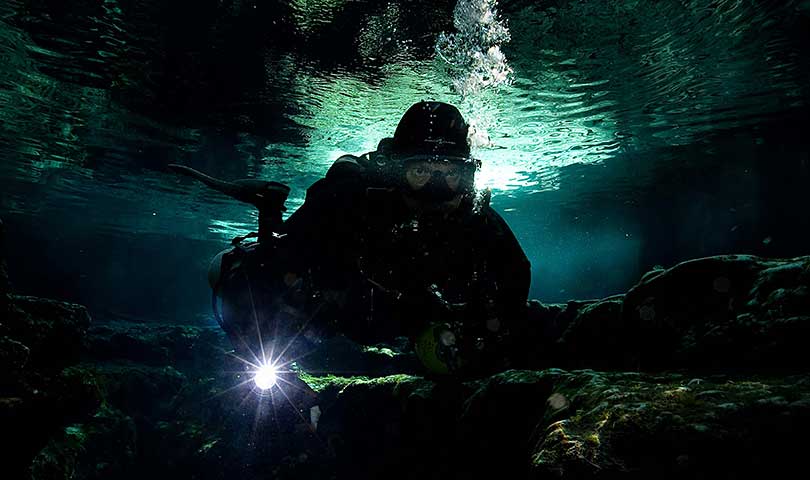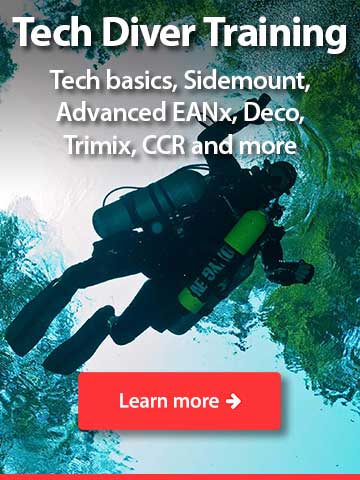CDS Basics Orientation

The prerequisites for any of our cave or technical diver courses include:
- Prior training or experience with either backmounted doubles or sidemount.
- Superlative buoyancy control, trim and propulsion skills.
Many students come to us having already taken some form of technical diver training, such as a Tech Basics or Technical Sidemount course. But what do you do if:
- You have little or no experience with the equipment?
- Your buoyancy control, trim and propulsion skills need work?
You could enroll in one of the courses just mentioned. This would take at least two days. However, if your goal is to qualify to take an NSS-CDS Apprentice Cave course, we have a better, more convenient solution.
The CDS Basics Orientation is designed specifically for those who can’t meet the prerequisites for cave ir technical diver training through other means. It is not a certification course, nor does it qualify you to do anything other than participate in further training — although you can make it a two-day a Sidemount Diver course, if desired.
The course focuses on:
- Becoming proficient in using sidemount or doubles.
- Perfecting your buoyancy, trim and propulsion skills.
This can be as little as a one-day program. However, as there are no shortcuts to safety, it takes as long as it takes.
Who Can Take This Course?
You:
- Must be at least 18 years old.
- Possess a minimum of Advanced Nitrox/Deco Procedures certification, or equivalent.
- Have logged at least 50 dives.
- Either be able to answer No to all the questions on an industry-standard Medical History form or obtain a physician’s approval for diving before the start of the course. If you require a physician’s approval, the doctor must sign off on the standard Medical Exam form. Forms signed no more than twelve months before the start of the course are acceptable — provided you have had no change in medical history since then.
What is Involved?
This course typically consists of:
- Self-study.
- At least one day of in-water training.
- At least 50 minutes of Actual Bottom Time.
As with a Rescue Diver course, it’s hard to quantify this experience in terms of a distinct number of dives, as there is a lot of up-and-down.
Where Does the Course Take Place?
This program takes place entirely in confined or open water. In north Florida or Mexico, we use one of our shallow-water springs or cenotes. In a cold-weather climate, we would typically us a large swimming pool.
How Much Does it Cost?
The exact cost of this program will depend on a variety of factors, such are:
- Will you be taking this course by yourself or with one or two other friends or family members?
- Are there any prerequisite courses you need to take in conjunction with the course which will result in your desired certification?
- Where will you be taking the course? (Courses conducted in north-central Florida generally have the lowest cost.)
Once we determine your specific needs, we can give you a firm price for all the required training. Bear in mind, the course fees generally cover just the cost of instruction. You are responsible for:
- Transportation to and from the course location and dive sites.
- Any overnight accommodations and meals.
- Supplying all required equipment and gas fills.
What Equipment Will You Need?
The minimum equipment requirements include:
- Mask and adjustable fins.
- Backup mask.
- Adequate exposure protection for the environment.
- Either back-mounted doubles or sidemount cylinders.
- Either a backplate/harness for backmount or an appropriate sidemount harness/air cell with adequate lift capacity.
- Two separate high-performance regulators.
- One primary and two backup lights.
- One backup reel/spool per diver.
- One cutting tools per diver (two recommended).
- One depth gauge/timer or mission-capable dive computer per diver (two recommended).
Some very specific requirements pertain to each items. Do not make any equipment purchases without first speaking to your instructor.
Note: if you will be traveling by air to the course site, we can help you to arrange the rental of heavier items such as tanks at your destination.
How Do You Sign Up?
The best way to get started is to simply contact us.

